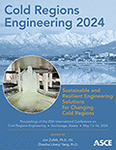Quantitative Analysis of Unfrozen Water Content of Muddy Clay under Extremely Low Temperature Freezing Conditions
Publication: Cold Regions Engineering 2024: Sustainable and Resilient Engineering Solutions for Changing Cold Regions
ABSTRACT
Water sealing of shafts and repair of subway tunnels all use liquid nitrogen for rapid freezing to realize emergency rescue, due to the unfrozen water content in the soil at extremely low temperatures will significantly affect the rescue project safety, therefore, it is necessary to quantitatively study unfrozen water content in soil at extremely low temperature. In this paper, based on LF-NMR, the unfrozen water content of the muddy clay at extremely low temperatures was measured, and the three cutoff values of the four types of unfrozen water in artificially frozen were quantified. The surface relaxivity value of muddy clay was obtained for the first time by combining with the MIP test. Results show that the three T2 cutoff values for the classification of strongly bound water, weakly bound water, capillary water, and bulk water are 0.13, 0.56, and 2.58 ms, respectively, and the freezing characteristic curve of clay at extremely low temperatures can be divided into the rapid decline stage and the slow decline stage. The value of surface relaxivity of the muddy clay is 12 nm/ms. This study facilitates the stability analysis of artificially frozen projects by investigating the unfrozen water content of the soil under extremely low-temperature conditions.
Get full access to this chapter
View all available purchase options and get full access to this chapter.
REFERENCES
Brownstein, K.R., Tarr, C.E. (1979). “Importance of classical diffusion in NMR studies of water in biological cells”. Phys. Rev. A 19 (6), 2446-2453.
Chai, M., Zhang, J., Zhang, H.u., Mu, Y., Sun, G., Yin, Z. (2018). “A method for calculating unfrozen water content of silty clay with consideration of freezing point.” Appl. Clay Sci. 161, 474-481.
Chen, Y. Q., Zhou, Z. F., Wang, J. G., Zhao, Y., Dou, Z. (2021). “Quantification and division of unfrozen water content during the freezing process and the influence of soil properties by low-field nuclear magnetic resonance”. J Hydrol. 602, 126719.
Gao, F., Song, Y., Li, Z., Xiong, F., Chen, L., Zhang, X., Chen, Z., Moortgat, J. (2018). “Quantitative characterization of pore connectivity using NMR and MIP: A case study of the Wangyinpu and Guanyintang shales in the Xiuwu basin, Southern China.” Internat J Coal Geol, 197: 53-65.
Jiang, Y., Xu, G., Bi, H., Shi, Y., Gao, Y., Han, X., Zeng, X. (2021). “A new method to determine surface relaxivity of tight sandstone cores based on LF-NMR and high-speed centrifugation measurements.” J Petro Sci Eng, 196: 108096.
Kozlowski, T. A. (2007). “Semi-empirical model for phase composition of water in clay-water systems”. Cold Reg Sci Technol, 49(3): 226-236.
Li, A. F., Ren, X. X., Wang, G. J., Wang, Y. Z., Jiang, K. L. (2015). “Characterization of pore structure of low permeability reservoirs using a nuclear magnetic resonance method”. J. China Univ. Pet. 39 (6), 92-98.
Liu, J., Xu, Q., Li, P., Pu, C., Zhao, K., Peng, D., Lei, M. (2023). “Determination of nuclear magnetic resonance T2 cutoff in remoulded loess by the freezing point.” Eur J Soil Sci, 74:e13406.
Spaans, E. J. A., Baker, J. M. (1995). “Examining the use of time domain reflectometry for measuring liquid water content in frozen soil”. Water Resour Res, 31(12):2917-2926.
Tao, Y., Yang, P., Li, L., Si, X., Jin, Y. (2023). “Characterizing unfrozen water content of saline silty clay during freezing and thawing based on superposition of freezing point reduction.” Cold Reg Sci Technol, 213: 103933.
Tian, H., Wei, C., Lai, Y., Chen, P. (2017). “Quantification of Water Content during Freeze–Thaw Cycles: A Nuclear Magnetic Resonance Based Method”. Vadose Zone J, 17, 160124.
Tice, A. R., Anderson, D. M., Sterrett, K. F. (1981). “Unfrozen water contents of submarine permafrost determined by nuclear magnetic resonance”. Developments in Geotechnical Engineering. 18: 135-146.
Williams, P.J. (1964). “Unfrozen water content of frozen soils and soil moisture suction.” G´eotechnique, 14 (2), 133–142.
Xiao, Z., Zhu, L., Hou, Z. (2022). “The change mechanism and a prediction model of unfrozen water content in sodium chloride soil.” Geoderma, 419, 115881.
Zheng, S., Yao, Y., Liu, D., Cai, Y., Liu, Y. (2019). “Nuclear magnetic resonance surface relaxivity of coals.” Int J Coal Geol, 205: 1-13.
Zhou, J., Zhou, H., Wang, C., Guo, Z., Pei, W. (2023). “Analysis of moisture migration, temperature, and pore structure characteristics of the muddy clay column subject to artificial ground freezing based on LF NMR”. Tunn Undergr Sp Tech, 133: 104948.
Zhou, J., Zhou, H., Zhao, W., Wang, C., Pei, W. (2023). “Moisture migration inference and calculation along the muddy clay column under unidirectional freezing based on LF-NMR.” Cold Reg Sci Technol, 215: 103985.
Zou, Y., Jiang, H., Wang, E., Liu, X., and Du, S. (2023). "Variation and prediction of unfrozen water content in different soils at extremely low-temperature conditions." J Hydrol, 624: 129900.
Information & Authors
Information
Published In
History
Published online: May 9, 2024
ASCE Technical Topics:
Authors
Metrics & Citations
Metrics
Citations
Download citation
If you have the appropriate software installed, you can download article citation data to the citation manager of your choice. Simply select your manager software from the list below and click Download.
